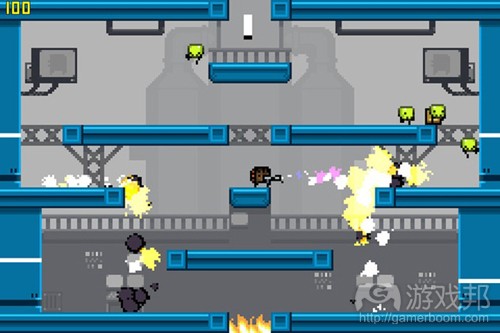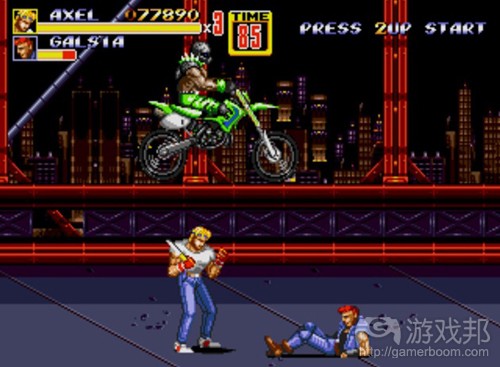分析如何地对移动设备设计复古游戏
作者:Brandon Sheffield
目前,我正在制作一款适合移动设备的16位街机赛车游戏,在此,我需要将旧式美学同新型输入方式与设计完美结合。为此,我体验(并观看视频)了大量旧作,试图抓住那种氛围,同时研究符合现代游戏的元素。
在此过程中,我从旧式游戏的优缺点中受到了大量启发。
整体设计
旧式游戏的画面技术缺乏一种精致感(在某些方面,我仍然无法理解那些怪才如何制作出适合世嘉硬件的《The Adventures of Batman and Robin》)。
由于硬件的简单与单一特性,你可以制作出一款自始至终,从菜单到音乐完全备齐的游戏。所有事物均以同样方式呈现在硬件的相同部分中,通常,游戏只含一种声音芯片,而硬件的局限特性常会引导游戏的设计方向。
在许多现代游戏中,多种多样的着色器、纹理以及照明布置,更是增加了菜单、角色、文本和环境风格保持一致性的难度。
对 于现代硬件上的复古游戏,情况就更有趣了。对于我的赛车游戏,创造3D道路是更简单的选择,但它该如何与车辆及背景结合呢?如果你观察iOS和 Android平台上的《Final Freeway 2R》,你会觉得比起正常的16位方法,3D道路更为顺畅,而随着车辆转动的镜头会让汽车的像素出现异常的运行方式,因为它是在硬件中进行旋转,而不是重 新绘制的内容。
显然,这是他们制作的复古风格——他们利用大量技术模仿老式画面,但在我看来,它比不上世嘉硬件上《Road Rash II》这类游戏中的泥泞、粗糙道路,后者会让你觉得道路与游戏融为一体。
现在,我们制作道路的方法是将画面横向分为一些小组块,随着镜头推近,画面会呈现出一些新组块。无论小段公路,还是线路之外的环境布置(比如水平线上设立的广告牌),我们均采用这种方法。而这全是效仿老式游戏的做法,但由于现代设备的强大功能,我们采用扫描线方式进行。虽然这不是最终方式,但是看到既非完全老套,又非完全新颖的方法完美地呈现在新型设备复古画面中则颇为有趣。
在此,我们受到的启发是,我们可以制作出具有综合性且内在统一性的小型游戏,但这存在一定的挑战,因为更加新型的技术会让开发者更易于制作出视觉效果很棒,但并不匹配整体风格的元素。实际上,通过旧式方法制作游戏更具难度!
精确操控
你会惊讶地发现,许多精美的16位老式游戏实则具备十分精确的控制方式。比如,世嘉五代上《Sub-Terrania》便是典型例子。好比你难以控制具有不少钝性的船只,但却可以操控它迅速转弯,这表明,如果你习惯了这些独特玩法,你可能会逐渐掌握这项技能。
对于不大成功的游戏,某个平台中具备太多钝性,或者不精确的击中模式可能会摧毁整个游戏体验。如今我们看到了这种对比,iOS平台上的《Super Crate Box》这类游戏拥有简单的操控方法(左、右、跳跃、射击),起初你可能认为这种方式不具精确性,但经过快速的学习,你会发现这是一种更棒的玩法。
这种操控方式的实现主要得益于静态、单一画面且容易操作的游戏环境。你无需做出翻墙或其它复杂动作——你只要跳跃,登上可以行走的平台、越过敌人、射击。另一方面,也有一些游戏则试图呈现完整的平台游戏体验,采用了三角跳跃以及重踏地面设置,但我总觉得这类游戏的控制方式不如真实的控制器顺手。
在此,我们受到的启发是,要确保控制方式体现游戏的设计模式。《Super Crate Box》中的简单环境便是一个例子,这款游戏的操控方式无法完美实现滚动与复杂的跳跃方式。另一个典型就是《Super Hexagon》这款容易让人神经紧张的硬核游戏,它只允许你左右移动。其控制方法既简单又精确,无论何时角色终结,你都很清楚是自己的过失造成的。
复古之感
复古游戏中更重要的因素莫过于老式氛围。我们难以指出如何准确触发玩家的这种情感,但许多成功的旧作均遵循一些相同的设计思路。
从失败中学习的模式:大部分出色的复古游戏会通过你的失败历程向你展示获胜渠道。漏过跳跃动作可以体现在图像尖峰的红色部分,而非蓝色部分,让你意识到可以躲避敌人的炮火——这些是旧式游戏的传授方法(当角色丧生后,你会回到该关卡的出发点)。起初你会觉得这种方式有点不公平,但通常如果你具有快速反应能力,你就可以掌握这种玩法模式而无需遭遇过多惩罚。
这种方法的难度并未受到现代游戏的青睐,后者通常会制作出针对休闲玩家的关卡和多种技能水平。但我认为这些旧作的硬核本质便是一种复古氛围,比如《Super Crate Box》、《 Super Hexagon》、《Super Meat Boy》这些游戏均证明,出色的控制方式外加惩罚难度以及学习模式确实可以吸引玩家,即使在今天也是如此(同时,为游戏名称添加“超级”一词可以提升销量)。
重复性会增加产品粘性——这也是为何孩子们仍会利用生词卡学习SAT单词。我们仍清楚记得自己童年时代的游戏,部分原因在于,为了通关,我们不得不多次体验游戏关卡。
独特的音乐:目前,音乐在许多游戏(尤其是AAA领域)中属于次要元素,它们只能环绕在背景中,没有任何主旋律。《超级马里奥兄弟》音乐的奇妙之处在于它为动作游戏增添了滑稽性。《怒之铁拳3》由Motohiro Kawashima作曲的音乐是早期尝试在电子产品中植入音乐元素的先例。总之,这些出乎意料的声音总会为游戏润色。
适当的控制:如先前所示,精确并非出色控制的标志,但控制方法必须与整款游戏相称。世嘉控制器上有6个按钮(游戏邦注“如果包括选择与暂停键,那么共有8个按钮),但你不必使用所有按钮。同时,游戏题材应符合玩家的喜好;我偏好平台与动作游戏中棘手且惯性的跳跃方式,但在格斗或赛车游戏中,我喜欢有一点回旋的余地。
发现新事物:我们难以在较大型的游戏中难以体现出16位游戏的吸引力。在这些逼真世界中隐藏路径与秘密会为玩家带来一种发现的快感。比如在TurboGrafx-16上的《Bonk’s Revenge》中,如果你不干扰敌人,他们就会在船上烹饪和四处徘徊。
当然,你还可能在《神秘海域3》的雕像中发现某个开发者的面孔,或是《使命召唤》中的有趣海报,但更棒的当数《光晕》中隐藏深处,难以发现的洞穴人。在街机赛车游戏《Outrun 2》中,当你保持在起始线上静止不动,而不是与对手一同出发时,你会发现,在等待的过程中,摇摆的旗帜会做出健美操、霹雳舞以及其它一系列动作。然而,玩家没有理由保持静止,95%的玩家不会看到这一画面,但这种做法确实有助于活跃游戏世界,为玩家带来一种发现的快感。
复古游戏的未来
在过去十年左右的时间内,受到复古元素激发的开发商已经着手考虑如何制作出具有这类效果的游戏。也许,这种复古氛围出自人们的怀旧之情——因为这一元素引发了游戏项目主管的共鸣?为了重新激发那种感觉,每天我都会体验大量世嘉与TurboGrafx游戏,并鼓励团队成员尽量经常抽空接触这类游戏。这是一个极有建设性的建议,我极力推荐有意制作复古游戏的开发者采用这一方法。
我并不清楚自己是否可以成功地为未来游戏营造出复古氛围,但是通过学习我已经清楚复古游戏对现在以及未来游戏的影响力。(本文为游戏邦/gamerboom.com编译,拒绝任何不保留版权的转载,如需转载请联系:游戏邦)
How do you recapture vintage magic on modern touch devices
by Brandon Sheffield
[Game Developer's editor-emeritus Brandon Sheffield explores the difficulties that arise when attempting to bring a retro-styled video game to mobile devices, marrying older aesthetics with newer input methods and design.]
One of my current game projects is a 16-bit arcade-style racer for mobile devices, which puts me in the position of trying to marry an older aesthetic with newer input methods and design. Along the way, I’ve been playing (and watching videos of) lots of games from the era, to try to catch hold of the vibe, while also seeing what works in modern times.
Through the process, I’ve found there’s a lot that can be learned from what’s good and what’s bad about older games.
Holistic design
With older games, graphical techniques were a lot less sophisticated (in certain ways — I will still never understand how those assembly wizards managed to create The Adventures of Batman and Robin on Genesis hardware).
Because of this simplicity and unity of hardware, you could create a game that felt completely self-contained from start to finish, from its menus to its music. Everything was being drawn in the same way by the same part of the hardware, there was usually just one sound chip, and the hardware’s limitations often guided what could and couldn’t be done.
In many modern titles, the variety of shaders, textures, and lighting arrangements that are possible make it tougher to keep menus, characters, text, and environments feeling like they’re 100 percent part of the same world.
For a retro game on modern hardware, this gets more interesting. For my racing game, it would be far easier to create a 3D road — but how would that fit with our pixelated cars and backgrounds? If you look at Final Freeway 2R on iOS and Android, the 3D road feels very smooth compared to a proper 16-bit approach, and the ability to move the camera as you turn makes the pixels of the cars behave in odd ways as it rotates in hardware instead of being redrawn.
That’s clearly what they’re going for — they’ve used a variety of techniques to try to emulate that old look, but for my purposes it can’t match the dirty, sketchy roads in Road Rash II on Genesis hardware, which make you feel like the road is the game.
Our current road approach is to slice the screen into small horizontal chunks, and as the camera moves forward, it looks for new chunks to render. This includes small bits of road, but also spaces out our sideline environmental dressings, which live as billboards along those horizontal lines. This emulates the approach of the older games, but is done for every scanline, since modern hardware is much more powerful. While this may not wind up being our final approach, it’s interesting to see how neither fully old nor fully new approaches work perfectly when recreating the vintage look on new devices.
The main lesson here is that with a smaller game, we have an excellent opportunity to create a product that looks very integrated and internally consistent, but it can be challenging because newer techniques make it easier to create something that looks almost as good but sacrifices that holistic feel. It’s actually tougher to do it the old way!
Floaty control
You’d be surprised how many of those old 16-bit games that we remember as being so sharp and precise actually had rather fiddly controls. In good games like Sub-Terrania on the Sega Genesis this was purposeful, and part of the challenge. Your ship was hard to control and had a lot of inertia, but was incredibly quick to turn, meaning if you got used to the unique playstyle, you could master it.
In less-successful games, having too much inertia in a platformer or imprecise hit boxes in a beat-em-up ruins an otherwise enjoyable experience. We see this comparison today, where games like Super Crate Box on iOS have simple controls (left, right, jump, and shoot) that at first feel imprecise, but have a quick learning curve, and ultimately inform better play.
This works because the environments are static, single-screen, and easy to navigate. You don’t need to wall-hop or do anything complex — just jump, land on a platform that you know is always there, jump over an enemy, and shoot. On the other hand, there are games that try to be full-on platform game experiences, with triangle jumps and floor stomps, and I’ve yet to see a one that didn’t frustrate me into wishing I had an actual controller.
The lesson here is to make sure your control method informs your design. The simple environments in Super Crate Box are a good example of this. With scrolling and complex jumps, the game just wouldn’t work as well as it does. Another great example is Super Hexagon, which is a twitchy, hardcore game that only lets you rotate left or right. It’s precise and accurate, meaning whenever you die, you know it’s your fault.
That old-school feeling
More important than anything else is the old-school vibe. It’s hard to pinpoint what exactly triggers that particular feeling in a player, but there are some common threads in the more successful older games.
Pattern learning through failure: Most good vintage games show you how to succeed by showing you how you can fail. Missing jumps, knowing that spikes show up over red pits but not blue ones, realizing you can duck to escape enemy fire — these were the teaching methods of old. (And when you die, it’s back to the start of the level with you.) It might feel slightly unfair the first time, but usually if you’re quick enough, you can learn the pattern as it’s happening without too much actual punishment.
This kind of approach to learning and difficulty has fallen out of favor in modern games, which have frequent checkpoints and variable skill levels for casual players. But I think the hardcore nature of these older games contributes a substantially retro vibe, and as games like Super Crate Box, Super Hexagon, and Super Meat Boy prove, good control plus punishing difficulty and pattern learning can really engage players, even today. (Also, adding “Super” to your game title boosts sales.)
Repetition bonds you with a product — that’s why kids still learn SAT words with flash cards. We remember the games from our childhood so well in part because we had to play through them so many times in order to beat them.
Distinctive music: Many games these days (especially in the triple-A space) give music the backseat, and choose to let it linger in the background without major melodic hooks. Super Mario Bros.’s music was fantastic because it added ragtime to an action game. Streets of Rage 3, composed by Motohiro Kawashima, is an early study in progressive, experimental electronica. The unexpected sounds give these games an edge.
Appropriate control: As previously hinted, precision isn’t necessarily the hallmark of good control, but the control method has to be appropriate for the game. There were six buttons (eight if you include select and pause) on the SNES controller, but you didn’t have to use them all. Also, your game’s genre may inform your players’ preferences; I’m a particular fan of sticky, inertia-free jumps in platforming and action games, but with flight or driving games, I like a bit of wiggle room.
Easter eggs: One thing that is more difficult to represent in larger games is the little subtle nuances that made 16-bit games so charming. Hidden paths and secrets in these living worlds led to a great feeling of discovery. In Bonk’s Revenge for the TurboGrafx-16, enemies on a ship cook food and wander about if you leave them alone.
Sure, you’ll find a developer’s face in a portrait in Uncharted 3, or an interesting poster in Call of Duty, but a better example would be Halo’s hidden, hard-to-reach cavemen. In the arcade racer Outrun 2, when you stay at the starting line instead of driving off with your peers, the flag waver will do stretches, breakdance, and a host of other actions while you wait. There’s no reason to do this — 95 percent of players will never see it — but that kind of dedication to the world really helps make it feel alive, and gives the player a great feeling of discovery.
Retro future
For the last decade or so, retro-inspired developers have pondered what makes these games feel the way they do. Ultimately, the vibe may come down to individual nostalgia — what resonates with that game’s director? To rekindle that feeling myself, I’ve been playing Genesis and TurboGrafx games daily, and encouraging my team to do that as frequently as they can as well. It’s been immensely informative, and I can’t recommend this enough for anyone trying to make a retro title.
I don’t know if we’ll be successful in taking that vintage vibe and bringing it into the future, but the learning process is already showing me how much vintage titles have to teach about present and future games. (source:gamasutra)










































 闽公网安备35020302001549号
闽公网安备35020302001549号